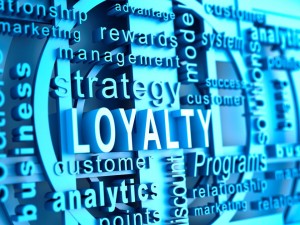‘These shoppers ain’t loyal’: The sentiment expressed in "Loyal," a song by American singer Chris Brown, struck a cord with me, particularly around consumer behaviour. Whilst Brown may be decrying the erosion of loyalty in a very different setting, it's not a stretch to imagine how his lyrics might ring true for many retailers. Consider how retailers try to lure shoppers via shiny promotions and special offers in face of a daunting reality - increasingly fickle shoppers are their big share of the market - as can be seen in this Infographic by MarketTrack showing that 80 per cent of shoppers are willing to switch brands or stores because of a promotion.
 Some of my co-workers may object to my playing ‘Loyal’ on repeat as I write this blog, but I’m trying to make a bigger point. Shoppers, much like my erstwhile colleagues, are experiencing loyalty fatigue. And, I don’t blame them.
Some of my co-workers may object to my playing ‘Loyal’ on repeat as I write this blog, but I’m trying to make a bigger point. Shoppers, much like my erstwhile colleagues, are experiencing loyalty fatigue. And, I don’t blame them.
Customer loyalty programmes are now the norm. The wallets of shoppers are bursting with loyalty cards and their phones flashing with promotional apps, increasingly in real time. This information overload diminishes the value that these incentives once had. The loyalty wars, just like the supermarket bread wars, are leaving CMOs sweating.
Today, the power and safety of a committed relationship is even more sought after. We know from our own experiences that loyalty can be borne out of many things: habit, fear, love, and convenience. So, what is it that makes shoppers return, bring others with them or be prepared to enter into an interactive marketing experience?
We teamed up with Northwestern University's Kellogg School of Management to see how retailers can cultivate loyalty and improve the customer experience, and how doing that might relate to marketing analytics. And, whilst there do seem to be a few universal likes, we found that understanding and segmenting your customers is crucial.
Retailers need to understand the key shopper segments to ensure their loyalty programme will entice individual consumers. The Kellogg School research found three core types of shoppers which retailers might find useful:
- Necessity shoppers:
Shopping is not considered a pleasurable activity. This segment tends to put off shopping as long as possible. - Practical shoppers:
Shoppers who enjoy shopping and find the experience satisfying overall. - Pleasure shoppers:
Engage in shopping for the enjoyment of the activity, typically treating it as an occasion; they are less interested in practical shopping.
Of course there are lots of influencing factors that create great customer loyalty. It starts with recognising what was once a competitive advantage is now an expectation. There is a need for retailers to invest time in understanding their customer base and listening to their comments and concerns in order to create a successful loyalty programme.
If you want to stop ‘Loyalty’ from ringing in your ears, check out the full report, Shopper Insights to Improve Retail Loyalty Programs, for more insight into what channels, demographics and rewards matter most. And feel free to share with us whether you are motivated by habit, fear, love or convenience? For me, convenience gets me every time.
